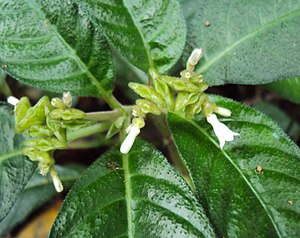Note: This is a project under development. The articles on this wiki are just being initiated and broadly incomplete. You can Help creating new pages.
Difference between revisions of "Ophiorrhiza mungos - Indian Snake Root"
| Line 1: | Line 1: | ||
[[File:Ophiorrhiza mungos 05.JPG|thumb|right]] | [[File:Ophiorrhiza mungos 05.JPG|thumb|right]] | ||
| + | '''Ophiorrhiza mungos''' is an erect, herbaceous, evergreen perennial plant with stems that can become more or less woody and persist; it usually grows 10 - 50cm tall, but can reach 100cm. The plant is harvested from the wild for local use as a medicine. | ||
==Uses== | ==Uses== | ||
| − | {{Uses|}}, {{Uses| | + | {{Uses|Cancer}}, {{Uses|Snakebites}}.<ref name="Uses"/> |
==Parts Used== | ==Parts Used== | ||
| − | {{Parts Used| | + | {{Parts Used|Whole plants}}. |
==Chemical Composition== | ==Chemical Composition== | ||
| Line 10: | Line 11: | ||
==Common names== | ==Common names== | ||
| − | {{Common names|sa=|en=|gu=|hi=|kn=|ks=|ml=|mr=|pa=|ta=|te=}} | + | {{Common names|sa=Sarpakshi|en=Indian Snake Root|gu=|hi=Sarhati|kn=Bili garuda paathaala|ks=|ml=Avlipori|mr=Mungusavela|pa=|ta=Kirippuntu|te=Sarpaakshi chettu}} |
==Properties== | ==Properties== | ||
| Line 28: | Line 29: | ||
==Habit== | ==Habit== | ||
| − | {{Habit|}} | + | {{Habit|Evergreen perennial}} |
==Identification== | ==Identification== | ||
| Line 47: | Line 48: | ||
==Mode of Propagation== | ==Mode of Propagation== | ||
| − | {{Propagation|}} | + | {{Propagation|Seeds}} |
==How to plant/cultivate== | ==How to plant/cultivate== | ||
| Line 53: | Line 54: | ||
==Commonly seen growing in areas== | ==Commonly seen growing in areas== | ||
| − | {{Commonly seen|}}, {{Commonly seen|}}, {{Commonly seen| | + | {{Commonly seen|Secondary forest}}, {{Commonly seen|Primary forest}}, {{Commonly seen|In moist localities}}. |
==Photo Gallery== | ==Photo Gallery== | ||
| Line 67: | Line 68: | ||
<references> | <references> | ||
| − | <ref name="chemical composition">[ | + | <ref name="chemical composition">[Chemistry]</ref> |
| − | <ref name="Leaf">[ | + | <ref name="Leaf">[Morphology]</ref> |
| − | <ref name="How to plant/cultivate">[ | + | <ref name="How to plant/cultivate">[http://tropical.theferns.info/viewtropical.php?id=Ophiorrhiza+mungos Cultivation]</ref> |
<ref name="Uses">Indian Medicinal Plants by C.P.Khare</ref> | <ref name="Uses">Indian Medicinal Plants by C.P.Khare</ref> | ||
</references> | </references> | ||
==External Links== | ==External Links== | ||
| − | * [ ] | + | * [https://www.flowersofindia.net/catalog/slides/Indian%20Snake%20Root.html Ophiorrhiza mungos on flowersofindia.net] |
| − | * [ ] | + | * [https://indiabiodiversity.org/species/show/263980 Ophiorrhiza mungos on indiabiodiversity.org] |
| − | * [ ] | + | * [https://www.easyayurveda.com/2019/06/10/sarpakshi-ophiorrhiza-mungos/ Ophiorrhiza mungos on easyayurveda.com] |
[[Category:Herbs]] | [[Category:Herbs]] | ||
[[Category:Pages without herbs images]] | [[Category:Pages without herbs images]] | ||
Revision as of 12:04, 10 June 2020
Ophiorrhiza mungos is an erect, herbaceous, evergreen perennial plant with stems that can become more or less woody and persist; it usually grows 10 - 50cm tall, but can reach 100cm. The plant is harvested from the wild for local use as a medicine.
Contents
- 1 Uses
- 2 Parts Used
- 3 Chemical Composition
- 4 Common names
- 5 Properties
- 6 Habit
- 7 Identification
- 8 List of Ayurvedic medicine in which the herb is used
- 9 Where to get the saplings
- 10 Mode of Propagation
- 11 How to plant/cultivate
- 12 Commonly seen growing in areas
- 13 Photo Gallery
- 14 References
- 15 External Links
Uses
Parts Used
Chemical Composition
Common names
| Language | Common name |
|---|---|
| Kannada | Bili garuda paathaala |
| Hindi | Sarhati |
| Malayalam | Avlipori |
| Tamil | Kirippuntu |
| Telugu | Sarpaakshi chettu |
| Marathi | Mungusavela |
| Gujarathi | |
| Punjabi | |
| Kashmiri | |
| Sanskrit | Sarpakshi |
| English | Indian Snake Root |
Properties
Reference: Dravya - Substance, Rasa - Taste, Guna - Qualities, Veerya - Potency, Vipaka - Post-digesion effect, Karma - Pharmacological activity, Prabhava - Therepeutics.
Dravya
Rasa
Guna
Veerya
Vipaka
Karma
Prabhava
Habit
Identification
Leaf
| Kind | Shape | Feature |
|---|---|---|
Flower
| Type | Size | Color and composition | Stamen | More information |
|---|---|---|---|---|
| {{{5}}} |
Fruit
| Type | Size | Mass | Appearance | Seeds | More information |
|---|---|---|---|---|---|
Other features
List of Ayurvedic medicine in which the herb is used
Where to get the saplings
Mode of Propagation
How to plant/cultivate
Commonly seen growing in areas
Secondary forest, Primary forest, In moist localities.
Photo Gallery
References
- ↑ Indian Medicinal Plants by C.P.Khare
- ↑ [Chemistry]
- ↑ [Morphology]
- ↑ Cultivation
External Links
Categories:
- Ayurvedic Herbs known to be helpful to treat Cancer
- Ayurvedic Herbs known to be helpful to treat Snakebites
- Herbs with Whole plants used in medicine
- Herbs with common name in Kannada
- Herbs with common name in Hindi
- Herbs with common name in Malayalam
- Herbs with common name in Tamil
- Herbs with common name in Telugu
- Herbs with common name in Marathi
- Herbs with common name in Sanskrit
- Herbs with common name in English
- Habit - Evergreen perennial
- Index of Plants which can be propagated by Seeds
- Herbs that are commonly seen in the region of Secondary forest
- Herbs that are commonly seen in the region of Primary forest
- Herbs that are commonly seen in the region of In moist localities
- Herbs
- Pages without herbs images





